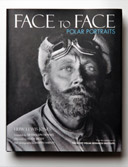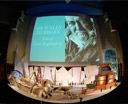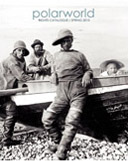 Our ProductsOur Resources |
This website requires the free Flash plugin to be installed.
Polarworld - discover more polar booksThe Arctic Book Review Bloody Falls of the Coppermine: Bloody Falls of the Coppermine: Madness, Murder, and the Collision of Cultures in the Arctic, 1913 McKay Jenkins Reviewed by Kenn Harper McKay Jenkins has written a compelling book about the murder of two Catholic priests by two Inuit (Eskimos) in the Central Arctic in 1913, and the subsequent police investigation and the trials of the accused. This is not virgin territory. In 1979, R. G. Moyles published “British Law and Arctic Men: The Celebrated 1917 Murder Trials of Sinnisiak and Uluksuk, First Inuit Tried Under White Man's Law.” But Jenkins has written a more detailed book than Moyles' spare account – he has put meat on Moyles' skeletal narrative, which dealt mostly with the trials. In particular Jenkins provides detailed background on the lives of the two priests, the context of life in the lower Mackenzie River area and the largely unknown land to its west, and the police investigation. The facts of the case are simple enough, the interpretation of those facts more difficult as, indeed, is shown by two different verdicts brought against the accused by two juries in neighbouring cities a week apart. In the western Canadian Arctic, regular Royal Northwest Mounted Police patrols began early in the twentieth century after American whalers had established at Herschel Island, west of the mouth of the Mackenzie River. Eventually a detachment was opened there. In the summer of 1913 two missionaries, Father Jean-Baptiste Rouvière, an Oblate who had served four years among the Dogrib and Hareskin Indians at Fort Good Hope, and Father Guillaume LeRoux, a man described as highly educated, a gentleman and a philosopher but given to frequent expression of hot temper, left the Roman Catholic mission at Fort Norman on the Mackenzie River to go northeast to proselytize among the Inuit of the Arctic coast, the people whom the explorer Vilhjalmur Stefansson had popularized as the “Blonde Eskimos.” (Diamond Jenness later corrected Stefansson's faulty record and described them as the Copper Eskimos.) When the priests were never heard from again, and reports began to reach Fort Norman that Inuit had been seen wearing priest's cassocks, it was feared that the two men had been murdered. Catholic authorities requested that the police investigate. In June of 1915 Inspector Charles Deering ("Denny") LaNauze, set out to do so. He was accompanied by two constables and an Inuit interpreter, Ilavinik, who was made a special constable for the investigation. In fact, the two priests had been murdered in November of 1913, only a few months after leaving Fort Norman. An elder of the Copper Inuit, Koeha, described the events for Denny LaNauze, and Jenkins recounts them at length in his book. Other Inuit recounted their version of the events to LaNauze with considerable hesitation. They were afraid. because John Hornby, another white man who had traveled through their land, had once told them that if they killed a white man, white men would return and kill them all. In the spring of 1916, LaNauze finally arrested the two suspects, Sinnisiak and Uluksuk, without resistance, at Coronation Gulf. Sinnisiak voluntarily gave a statement. The two Inuit had followed the priests as they headed from Coronation Gulf back inland to their winter camp. Eventually they caught up with them and travelled with them for some distance. Ilagoak (the Inuit name for LeRoux, the volatile priest) was carrying a rifle and the Inuit thought he was angry with them and became convinced that he was going to kill them. When Uluksuk and Sinnisiak tried to talk with each other, LeRoux objected and put his hand over Sinnisiak's mouth. The priest was pushing Sinnisiak and the man became frightened. Both Inuit wanted to abandon the priests and turn back but LeRoux would not hear of it. After another altercation between the priest and Sinnisiak, involving more pushing and shoving by the priest, Sinnisiak acted. He stabbed LeRoux, but Uluksuk completed the killing. Kuleavik (Rouvière) ran, whether to get a gun or simply to flee the Inuit were not certain, but he had handed LeRoux a rifle earlier, which caused the Inuit to mistrust him despite his previous gentle nature. Sinnisiak shot him from behind. Uluksuk stabbed him in the side and Sinnisiak finished the job with an axe. Then the Inuit each ate a piece of LeRoux's liver. It was apparent that the Inuit had killed the priests because they feared for their own lives. The trial began on August 14, 1917 in Edmonton. But the crown had a surprise in store for the defence. They tried only Sinnisiak, and only for the murder of Father Rouvière. It was a trial by a jury of six. The loquacious Charles Cursolles McCaul, crown counsel, made it clear in his lengthy introduction that this was no ordinary murder trial, but one intended to extend the reach of Canadian law to the remotest part of the country. But he spoiled his otherwise brilliant address when it became clear that his real purpose was to make the Arctic safe for white men, who would come to explore and exploit the region's resources: "You, gentlemen, can understand how important this is: white men travel through the barren lands; white men live on the shores of Bear Lake; white men go to the shores of the Arctic Ocean; and if we are to believe the reports of the copper deposits near the mouth of the Coppermine River, many white men more may go to investigate and to work the mines. The Eskimo must be made to understand that the lives of others are sacred, and that they are not justified in killing on account of any mere trifle that may ruffle or annoy them." Sinnisiak, uncomprehending and dressed in skin clothing, as befitted a show trial, fell asleep during McCaul's lengthy address, as did Uluksuk. Bizarrely, a tub of ice water had been placed near him, so that he could dip his feet in whenever he needed to cool off. The defence argued for acquittal on the grounds that the Inuk knew nothing of the white man's law and should not be judged by it, and that he had acted in self-defence, thinking he was about to be killed by the priest. Chief Justice Harvey in his charge to the jury argued against acquittal. But the unexpected happened. The jury deliberated for little more than an hour, and came back with a verdict of not guilty. Sinnisiak, confused, blurted out, “It is not true. I did kill him.” The trial had lasted four days. The crown counsel and the judge were outraged. They felt the jury had been influenced by a sympathetic local press and by public sentiment. McCaul even suggested that some jurors held an anti-Catholic bias and were reluctant to find guilty the killer of a priest. But the crown had an ace to play. Sinnisiak had been charged and acquitted only of the murder of Father Rouvière. McCaul filed charges of murder against both Sinnisiak and Uluksuk jointly for the murder of LeRoux. He also applied before the same judge for a change of venue because he claimed there was prejudice in Edmonton against the prosecution. The judge agreed. The trial would commence on August 22 in Calgary. The argument this time boiled down to a question of whether the justice system should be used as a tool of government policy. McCaul insisted that the Inuit should be convicted but the mandatory death sentence be commuted and they be sent back to live among their own people as an example of the mercy of the British justice system, and to spread some of the new ideas they had learned while in “civilization.” This time the prosecution got what it wanted. The jury was out for only forty-six minutes and returned with a verdict finding both men guilty of murder, but with a strong recommendation for clemency. Judge Harvey passed sentence several days later in Edmonton. The law allowed no sentence other than the death penalty for murder. Accordingly, the judge sentenced them both to death by hanging on October 15. He explained, through the 17-year-old half-Inuit interpreter, Patsy Klengenberg, that the Minister "authorizes me to state the sentence will be commuted." The death sentences of Sinnisiak and Uluksuk were commuted to life imprisonment at the police detachment in Fort Resolution. They were not confined, but did odd jobs around the post. The police report for 1919 described them as model prisoners. In May of that year, they were released from custody. Eventually they returned to their homes, well-off in material goods but, according to the police, arrogant. Uluksuk, in fact, became troublesome, bullied other natives and was said to be a thief. In 1924 he was killed by another native, Ikayena. Sinnisiak died in 1930. Jenkins' book is detailed, fast-paced and, in its essential details, accurate. Although he follows the story of Sinnisiak and Uluksuk with a brief discussion of the direction that policing and justice took in the Arctic after this case, it is a shame that he does not more carefully prepare the reader with at least some reference to the earlier murders of the adventurers Radford and Street. Stylistically this may have been difficult – those murders happened earlier, in 1911, but the protracted investigation lasted longer, only ending in 1917, and then without a trial. But the reader should have known that the wheels of justice had been set in motion against Inuit accused before this case. At first I was put off by the appropriation of the term “Bloody Falls” in the title of this book. Bloody Falls has been forever associated with the Chipewyan massacre of Inuit there in July 1771, as witnessed and described by Samuel Hearne. But in fact, the title becomes appropriate as Jenkins builds his story. I find Jenkins habit of notation annoying. Very often, a superscript number appears at the end of a paragraph not containing a quotation, directing us to the chapter notes at the back of the book, as if we needed a source for every sequential event in the story. But too often a direct quotation is accompanied by no reference at all. The use of the term “Barren Lands” to describe the area between Great Bear Lake and Coronation Gulf is not consistent with my understanding of how the term “Barren Lands” is used today. For me, and I would suggest for most today, the Barren Lands is the broad sweep of tundra between the tree line and Hudson Bay and the Arctic Coast.. However, since the policeman, LaNauze, describes the area of his overland travels in investigating the case as “the barrens” and “the Barren Lands,” I assume that the term must have been more widely applied almost a century ago. In commenting that Europeans described the Inuit as “nomads,” Jenkins counters that “the Eskimos had been in the same place for at least five thousand years.” This shows a lack of understanding of Inuit migration. Without quibbling over the number of years, it is quite safe to say that the Inuit encountered by most explorers and missionaries were not the direct descendants of Inuit or their precursors who had been there thousands of years earlier. Inuit were nomadic. Some of Jenkins' turns of phrase are beautiful in their simplicity. (“Since every river has myriad branches leading into it, explorers moving upstream have exactly as many ways of getting lost as there are creeks. Minus one.”) (“They did have a rifle, but a rifle with no hunting skills is a walking stick.”) (“Rumors about the priests swirled around the Arctic like a winter wind.”) Other sentences are mystifying in their confusion. What is one to make of a sentence like this: “Shouldering a canoe, perhaps with a bag or two of gear occupying hands that would otherwise be engaged in swatting clouds of blackflies, offers challenges to a paddler's patience that are far less happily engaged than, say, a good set of rapids.”? Many of his quotations are well-chosen. Imagine the sheer desperation that young Father Rouvière felt in writing these words: “We have arrived at the mouth of the Copper River. Some families have already left. Disillusioned with the Eskimos. We are threatened with starvation; also we don't know what to do.” And his speculations are apt when he delves into the same young man's inner thoughts: “How could Christian doctrine, its parables sprouted from a world that was both warm and agricultural, ever have a practical relevance to people who lived where nothing edible grew?” Jenkins places great reliance on a four-part article that Denny LaNauze wrote in 1937. The quotations he extracts from this piece are a type of prose rarely found in a police report and show LaNauze to have been a very sensitive officer. In describing his interpreter, Ilavinik, LaNauze wrote, “We are now fast friends. Eskimo cannot be treated on the footing of master and servant.” In commenting on the Inuit stories of the killing of the two priests, he writes, “Amongst these people, what one knows is known by all.” Or consider this, on the end of a September day: “The setting sun turned the brown of the barrens into a royal purple, and before darkness the pinched face of a great full moon rose over the hills to the East in a turquoise sky.” One wishes there were more writings from the pen of Denny LaNauze. It is disappointing that Jenkins perpetuates the myths about the derivation of “Kabluna” (qallunaaq), the word for white man. Suffice it to say that is does not mean “Long Eyebrow” (page 35). And minor errors irk. I doubt if “a whaling ship would be waiting at Fort Norman...” (page 140). It was not missionary activity that caused Inuit to leave their sealing grounds early and devote themselves to fox trapping, but the incursion of traders into their lands (page 259). The author has confused Inuit and the Innu (Indians) of Labrador in a quotation (“We have to follow Innu ways...”) to illustrate “Eskimo religion” (page 49); in fact, the entire quotation, from Brody, is from a section on Innu religion. And he has Inuit stalking seals “on their hands and knees,” while their dogs are simultaneously sniffing out seal breathing holes (page 53), two activities which could not happen at the same time, and at any rate stalking seals basking on the spring ice is not done on hands and knees. A bigger map of the immediate area of the killings and the investigation would have been helpful. Overall, this is a satisfying, informative and well-written account of an important event in the history of the Copper Inuit. Of all Inuit in Canada, their initial encounters with white men, and the changes wrought on their society by those encounters, were perhaps the most sudden. Northerners, especially Inuit, should read this book. |
|
||
follow us  | join us | join us  | home | contact | home | contact
|
||||
|
© Copyright Polarworld Ltd
SiteWizard.co.uk Web Site Design Company |
||||


